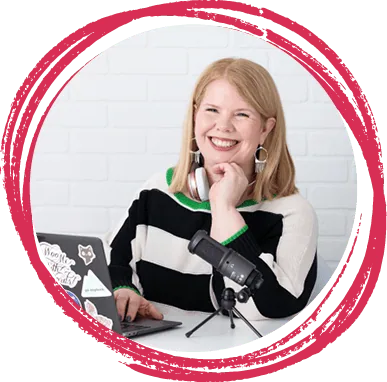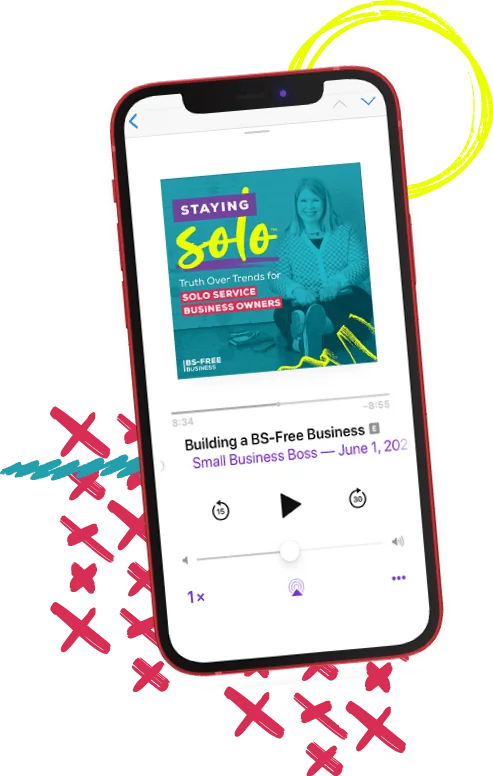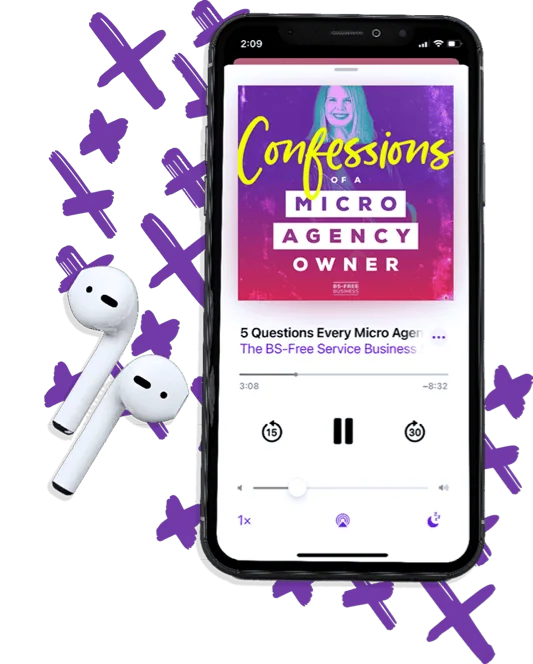
Search the site:
No Sleaze, No Cheese: Discovery Calls That Actually Work
Let’s cut the bullshit: If your discovery calls feel like a nightmare of giving away free advice and fumbling through awkward sales scripts, it’s not your fault.
The whole online business world has been feeding you this nonsense about discovery calls being all about psychological hacks and sleazy sales tactics.
You’ve been told you must over-deliver for free, act like a super-helpful expert, and convince people to hire you without admitting you’re selling anything.
Newsflash: That garbage doesn’t work. Not for Done-For-You service providers.
Today, I’m breaking down how to do discovery calls in a straightforward, honest, and effective way. And the best part? It’s way simpler than you’ve been led to believe.
What is a Discovery Call?
Let’s start with the basics: What is a discovery call?
A discovery call is a focused, professional conversation between you and a potential client to discuss how you can work together.
It’s not a casual ‘get to know you’ chat or some high-pressure sales pitch. It’s a problem-solving discussion where you clarify your services and assess if there’s a good fit to move forward.
Discovery calls are a strategic part of the process of landing new clients. You want your discovery calls to:
- Establish Whether You’re the Right Fit: You’re both trying to determine compatibility. It’s not about convincing anyone—it’s about finding a strong mutual fit.
- Clarify the Problem and Provide a Solution: The call allows you to understand their problem and explain how to solve it.
- Set Expectations: You’re establishing what the working relationship will look like, including your process, your approach, and how things will work if you decide to move forward.
The Discovery Call Disconnect for Service Providers
Now, let’s talk about how discovery calls are taught in the online business world, as it’s messed up so many service providers in the past few years.
Why? It’s mainly because the way celebrity entrepreneurs teach discovery calls is wholly disconnected from their actual purpose—which is to ‘discover’ if you’re a fit to work together, not to pressure someone into saying yes.
As a result, too many service business owners have been taught to execute discovery calls in a way that uses psychological “hacks” to get someone to buy. Or even get people to chat with them on Zoom as a “free” session and then upsell them into services.
Ethical problems aside from using psychological triggers in a manipulative way or baiting and switching people so you can sell to them, trying to force a call to go a certain way isn’t authentic, and it’s not effective. You can’t approach sales conversations with a one-size-fits-all mentality when your services are designed to meet the unique needs of individual clients.
And don’t get me started on the various tactics used to avoid calls entirely. I’m talking about fancy funnels, complicated booking systems, endless application forms or having to sit through a webinar.
While you should filter people for fit, these systems are designed to get micro-commitments so people will buy from you. This “cold” process feels impersonal, and when you’re selling a done-for-you service or working with someone longer-term, you need to have a connection. (That said, there are times when a call isn’t needed or doesn’t work for people due to capacity/energy, but that’s not what I’m speaking to.)
Turning Discovery Calls Into Real Conversations
Discovery calls are not just some casual chit-chat. And they’re not about manipulating someone into hiring you.
Here’s what discovery calls should be:
- A Problem-Solving Conversation. Your job during these calls is to provide facts and solve a problem. You’re not there to push, persuade, or convince anyone. Your role is to present the facts about what you do, how you do it, and how that might work for them. This is where you showcase your expertise and demonstrate that you understand what they need.
- A Fit-Finding Mission. Not everyone is a fit for your services, and that’s okay. Screening for fit is essential. The goal isn’t to book as many calls as possible. It’s about having meaningful conversations with the right people. (A short application or quick email exchange can help filter out people who are better served elsewhere so you’re not wasting anyone’s time.)
- A Reality Check About What You Offer. You’re not promising them the moon. You’re being upfront about what’s possible and how you can help. If they’re not a fit, be willing to walk away. You should be upfront and honest about it if it won’t work.
It will feel much more natural when you have a clear purpose for your discovery calls and you’re not trying to come in with the hard sell.
Speaking of natural, you don’t have to show up on these calls pretending to be someone you’re not. The person they meet on the call should be the person they get when they work with you.
The goal is for you to share your expertise and be clear about how to help. You’re letting them know what they can expect in terms of your process, your style, your approach—it’s all part of the package. If someone doesn’t vibe with that, they’re not your client.
Rethinking Your Discovery Calls
So, we’ve covered all the ways discovery calls get screwed up and why the usual advice doesn’t work for DFY service providers.
Now, let’s flip the script. What would it look like if your discovery calls were simple and effective and you could feel good about them?
Here’s how to do it:
Use Applications Wisely
Overcomplicated applications are one of the biggest barriers between you and good clients. Your application process should be simple and direct enough to understand their needs before you talk.
The goal isn’t to make someone fill out a novel just to get on a call with you. A streamlined application also helps you screen out those who aren’t a match, saving time and energy.
Screen for Fit
Talking to anyone and everyone is a waste of your precious time. Your job is ensuring you’re only talking to the right people. Screening for fit is about recognizing that not everyone will be a match for your services, and that’s perfectly fine.
This isn’t about rejection—it’s about protecting your time and making sure you only enter into conversations where there’s actual potential for a good working relationship.
Letting someone go because it’s not the right fit is a strength, not a weakness. (Especially if their budget is $500 and your starting price is $5k.)
Have a Plan for the Call
Too often, clients dominate the conversation, unloading all their thoughts, concerns, and backstory without giving you a chance to explain how you work or what the process looks like. And while it’s great that they feel comfortable sharing, leaving the call without communicating how you can help is a problem.
The solution? You need to take control of the agenda from the start. Showing up with a clear plan demonstrates confidence and professionalism, making it evident that you know what you’re doing. When you outline the structure of the conversation right away—like how much time you have, what you’re going to cover, and what they can expect—it instantly puts them at ease.
Not only does this make for a more productive conversation, but it also builds trust. When clients feel like you’re in control and have a plan, they’re more likely to see you as someone who knows their stuff. And most importantly, it keeps things on track so you can figure out if you’re a fit to work together. Because that’s what the call is about: determining fit, not just having a casual, unstructured chat.
Solve Problems, Don’t Push
Your job on a discovery call is to help them understand their problem and show them how you can solve it. But here’s the thing—this isn’t the time to give away specific tactics, strategies, or a detailed step-by-step plan. That’s what they pay you for. Instead, you should focus on discussing your process, your experience, and how you approach solving their problem. They should walk away with clarity about how you work, not a free coaching session.
This approach not only keeps you from wasting your time giving away valuable advice for free, but it also reinforces your authority. You’re not there to be their free consultant but to discuss whether working together makes sense.
And if it’s not a fit? Walk away. Seriously!
There’s no need to pressure someone into working with you if it’s not right. By focusing on solving problems rather than pushing for a sale, you’re already setting yourself apart from the sleaziness and cheese tactics everyone hates.
Wrap Up the Call with Clear Next Steps
Wrapping up a discovery call is just as important as how you start it. This isn’t just a polite goodbye—it’s your moment to clarify the next steps.
If it’s not a fit, say so. Don’t waste their time or yours by dragging things out. A simple, “I don’t think I’m the right person to help you, but I appreciate your time,” is enough.
If it is a fit, outline exactly what happens next. Are you sending a payment link, a proposal, or a contract? Whatever it is, explain the process and the timeline.
Before ending the call, ask if they have any final questions. This clears up any hesitation and shows you’re thorough. Then, recap what’s been discussed, confirm the next steps, and confidently end the call.
Turn Your Conversations Into Clients
Discovery calls don’t have to be painful or awkward or feel like you’re being sleazy or cheesy.
They’re about clarity, solving problems, and finding the right fit. Focusing on connection and professionalism instead of gimmicks and hacks will attract the right clients and leave the wrong ones behind.
Throw out the scripts, the endless funnels, and the high-pressure tactics.
Show up with a plan, communicate clearly, and be willing to walk away if it’s not a match. That’s how you turn discovery calls into powerful, straightforward conversations that turn into clients you love working with.

I’m Maggie Patterson (she/her), and services businesses are my business.
I have 20+ years of experience with client services, am a consultant for agency owners, creatives, and consultants, and vocal advocate for humane business practices rooted in empathy, respect, and trust.
Read or Listen to the Latest
Check Out These Posts
For Solo Business Owners

Growing a solo service business is tough.
It’s even harder when you’re bombarded with BS advice that steers you away from your values and why you started your business in the first place.
This is the podcast for solo creatives and consultants who want to remain as a team of one and have zero interest in the hustle and grind of typical business teachings.
Subscribe now and never miss an episode.
For Micro Agency Owners
Most podcasts for agency owners obsess over revenue growth as the ultimate success metric.

But here’s the truth: not everyone wants to make millions. Your goal might be to build a sustainable business that lets you have a life and doesn’t run you into the ground.
Join me as I spill my shameless confessions and share everything I’ve learned about building a micro agency that skips the BS of tired and typical agency teachings.
Follow Now on All Major Podcast Platforms








